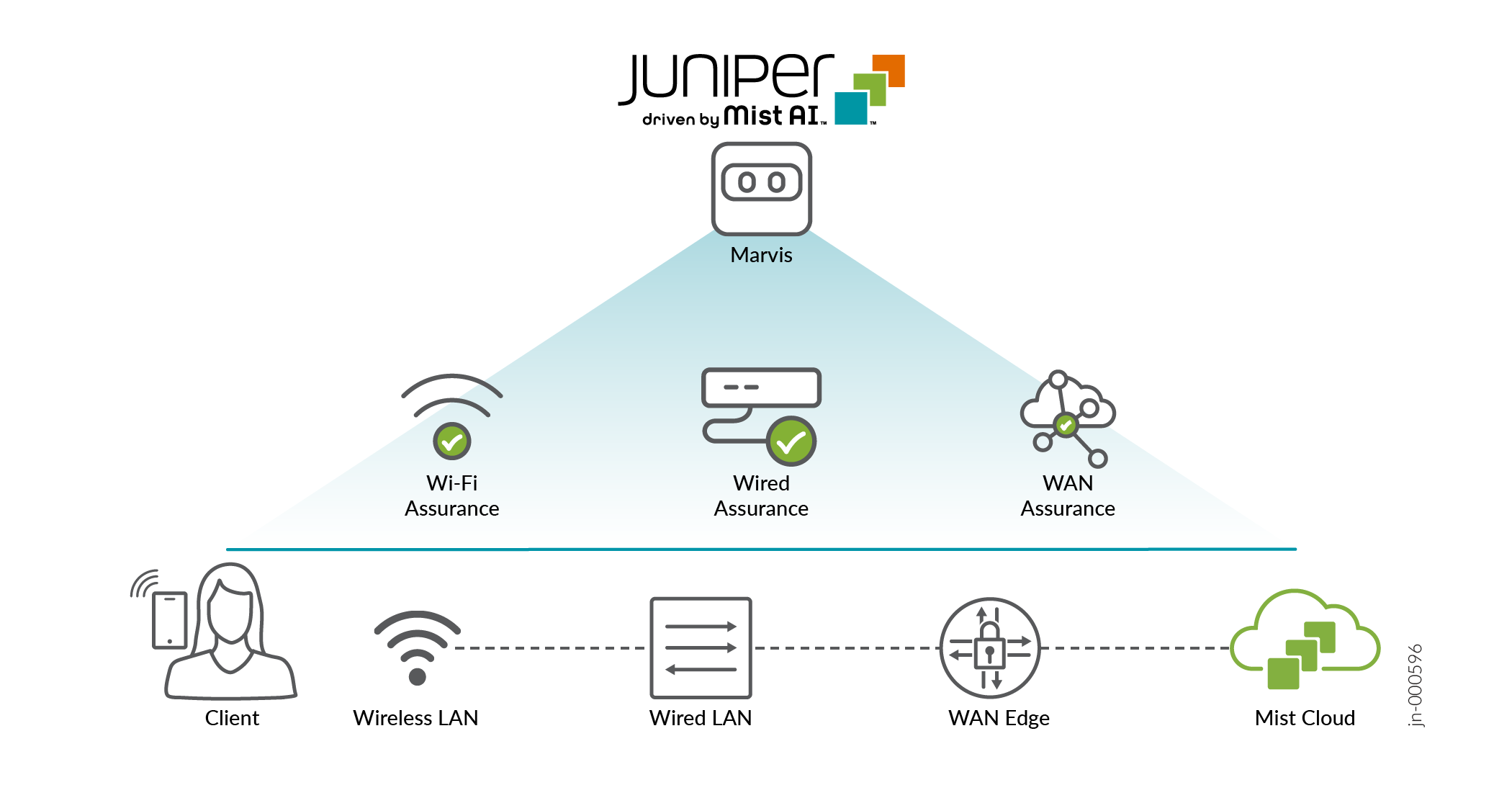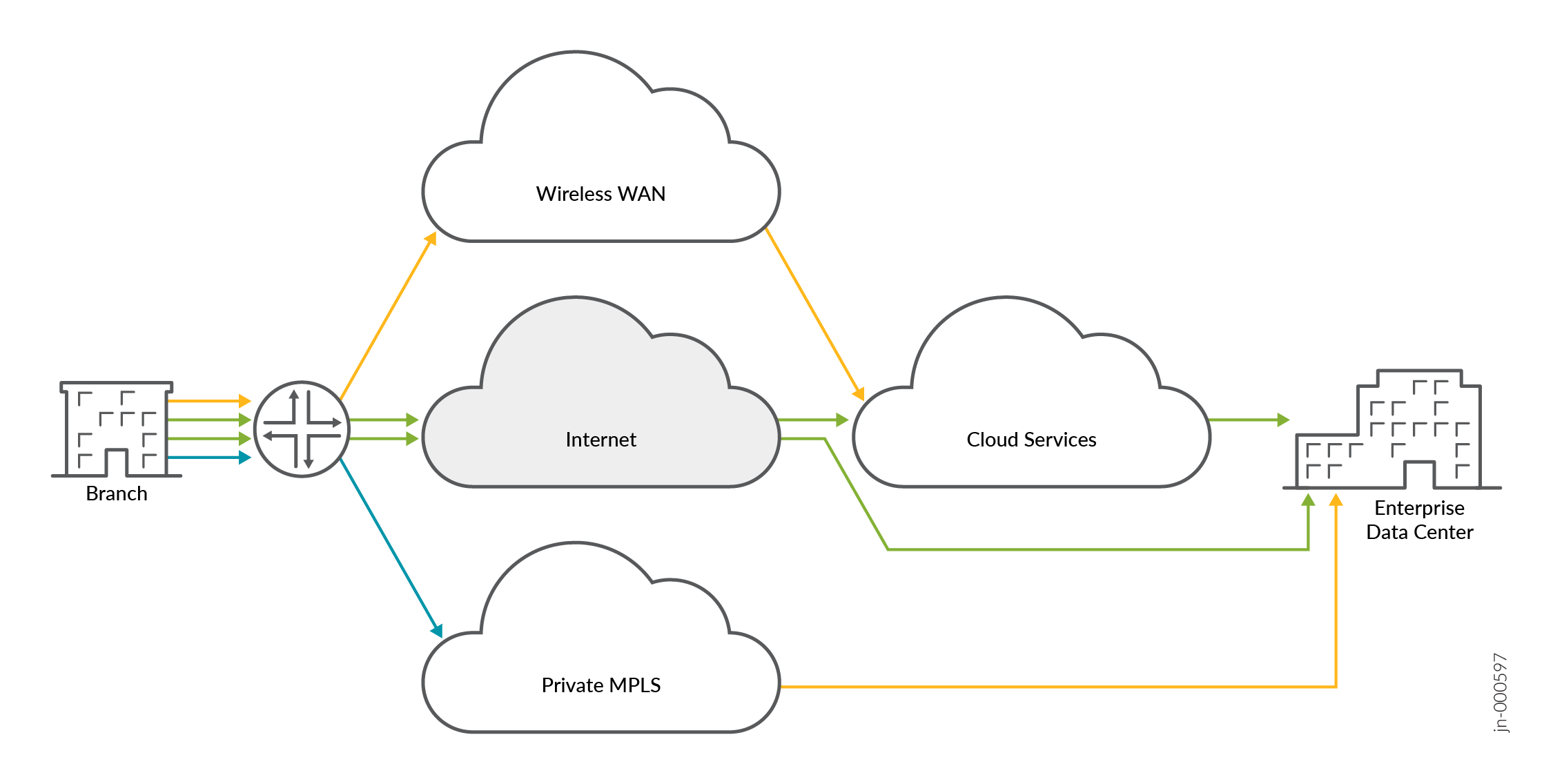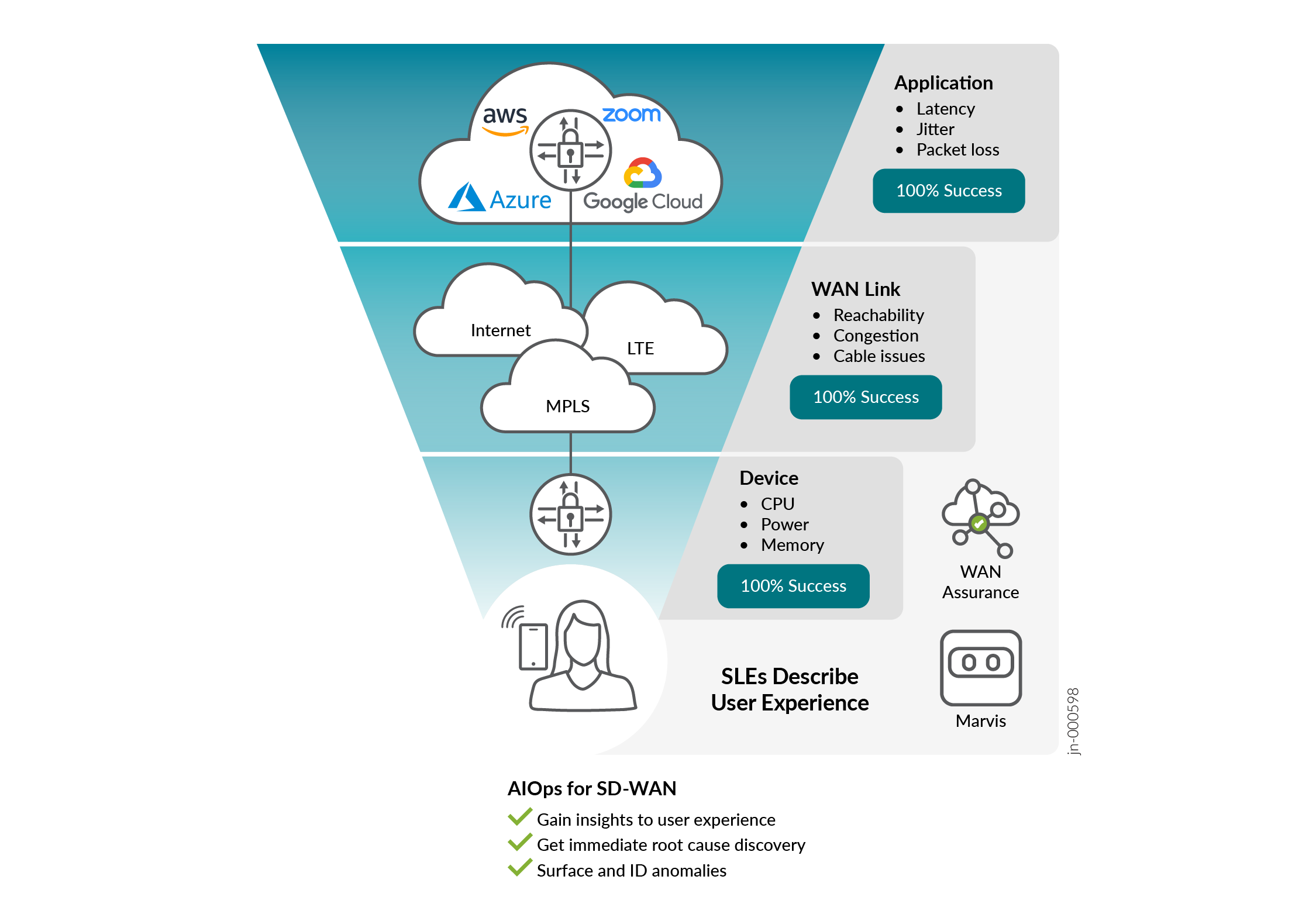Juniper Mist WAN Assurance 개요
주니퍼 Mist™ WAN Assurance의 목적, 기능 및 이점에 대해 알아보세요.
WAN 에지는 엔터프라이즈 네트워크가 외부 세계로 연결되는 경계점입니다. 이 경계는 중요한 보안 및 문제 해결 핫스팟입니다. WAN 에지는 엔터프라이즈 네트워크와 외부 환경을 연결하는 간단한 경계가 될 수 있습니다. 그러나 WAN 에지는 Mist AI™ 디바이스로 구동되는 주니퍼® SD-WAN이 될 수도 있습니다. 옵션으로는 주니퍼® SRX 시리즈 방화벽, 주니퍼® 네트웍스 Session Smart™ 라우터 또는 주니퍼 Secure Edge와 같은 클라우드 솔루션이 있습니다.

WAN 에지는 주니퍼의 AI 기반 SD-WAN 솔루션으로 혁신되며 중앙 정책 시행 지점(PEP) 역할을 합니다. 주니퍼 SD-WAN은 Juniper Mist WAN Assurance 클라우드 서비스와 결합되어 레거시 SD-WAN 솔루션의 보안, 모니터링, 문제 해결 문제를 다수 해결합니다. 주니퍼 Mist Wired Assurance, Juniper Mist Wireless Assurance, 그리고 이제 Juniper Mist WAN Assurance를 통합하여 네트워크 전반에 구축, 모니터링 및 문제 해결을 제공합니다. Juniper Mist WAN Assurance는 SD-WAN을 통해 브랜치 오피스를 주니퍼® 세션 스마트™ 라우터 또는 주니퍼® SRX 시리즈 방화벽과 안전하게 연결합니다.

사이트 간 연결(SD-WAN)
WAN Edge는 Mist AI™ 기반 SD-WAN와 통합주니퍼® 통해 혁신됩니다. WAN Edge 디바이스는 Juniper Mist WAN Assurance를 통해 빠르고 안전하며 애플리케이션 인식이 가능해집니다. 원격 사이트에서 발생하는 소프트웨어 정의 WAN 트래픽은 추상화된 오버레이를 통해 비용이 저렴한 광대역 서비스 프로바이더로 이동합니다. 이 연결 설계는 고가의 레거시 MPLS 솔루션을 대체합니다. 에지 디바이스는 MPLS, 광대역, 위성 및 LTE를 비롯한 다양한 연결 유형에서 상태 저장 페일오버를 제공합니다. 중요한 애플리케이션에 대한 이러한 실시간 스위치는 사용자가 인식할 수 없습니다. 또한 Juniper Mist WAN Assurance 상태, 터널 활동, 연결 및 활성 세션에 대한 타겟 인사이트를 통해 WAN 에지에 가시성을 제공합니다. 소프트웨어 정의 공간을 만들면 액세스 및 보안에 대한 제어를 강화하면서 애플리케이션 수준에서 트래픽에 영향을 미칠 수 있습니다.

Juniper Mist WAN Assurance SLE(Service Level Expectation)
Mist의 예측 분석 및 상관 관계 엔진(PACE)은 데이터 사이언스 및 머신러닝을 제공하여 최종 사용자 경험을 이해합니다. WAN SLE 메트릭은 WAN 에지 상태, WAN 링크 상태 및 애플리케이션 상태입니다. Juniper Mist WAN Assurance는 사용자 경험에 영향을 미치는 WAN 문제의 근본 원인을 파악합니다. 서비스 수준 기대치에 따라 운영이 단순화되고, 최종 사용자 경험에 대한 가시성이 향상되며, 네트워크 모니터링 및 문제 해결이 간소화됩니다.

Mist 관리 모델
주니퍼의 AI 기반 SD-WAN 솔루션은 브랜치 무선, 유선 및 SD-WAN을 위한 단일 관리 플랫폼입니다. 주니퍼 SD-WAN ZTP(제로터치 프로비저닝), 수명 주기 및 구성은 단일 Mist 대시보드를 통해 수행됩니다.

다음 비디오에서 Juniper Mist WAN Assurance 기능에 대한 개요를 살펴보십시오.
Juniper MIST WAN Assurance delivers insights and troubleshooting driven by MIST AI into the WAN, exposing many factors that impact user experience across your distributed enterprise. WAN Assurance complements your SD-WAN deployment and is focused on delivering the best user experience, from client to the cloud. SD-WAN solutions dynamically optimize traffic flows across the WAN based on an SLA policy for your applications.
However, these SLAs are set once at the beginning and don't account for changes over time that impact the WAN, rendering these static SLAs ineffective. In contrast, WAN Assurance is centered around the concept of the user minute, which is represented by Service Level Expectations, or SLE for short. If a user is experiencing a poor Microsoft Teams call, then the user is having bad user minutes.
Let's see what this looks like in a Juniper Cloud instance. From the monitor view, we select WAN, choosing from the time frame over the last seven days, and we see three SLEs for the WAN. The first one is Gateway Health, which accounts for the overall state of the SRX WAN edge device itself.
We track CPU, memory, temperature, fan, and power, all of which account for the overall device health. WAN Link Health represents the overall state of the WAN connections to the device. It tracks IPsec status, routing, and the WAN interfaces.
Thirdly, there's App Experience, which accounts for factors that impact application performance based on traffic. This SLE tracks latency, jitter, packet loss, and round-trip time. Together, these three SLEs describe how WAN performance is impacting overall user experience.
Let's ask Marvis what's happening with Microsoft Teams. By simply typing, obvious Teams call is bad, Marvis begins a root cause analysis. Marvis first responds by listing five Teams sessions from the past 24 hours.
We select the troublesome session from the list. Marvis quickly responds that the bad Teams experience was due to high latency on the Gateway SRX. Marvis also shows where the issue is in a simplified network diagram.
It displays how Abhi's MacBook is connected wirelessly to an access point, which in turn is connected to an EX access switch, and finally, the traffic is sent to the WAN via the SRX gateway. Marvis visually shows how each of these points in the network are impacting user experience. We see the AP and the gateway devices may be impacting experience.
We click the AP first. There is some non-WiFi interference in the 5GIG band that could be impacting users. Next, we select the gateway device.
We see it has high latency in one of its WAN links due to slow response from the application server. Marvis makes it that easy to determine root cause analysis of issues impacting user experience. By correlating across Wi-Fi, wired, and WAN, we are able to drive a better user experience within our sites, out of our sites, from client to cloud.
